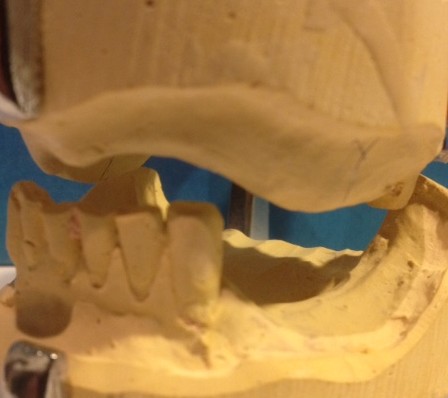PARTIAL LOWERS ARE ESSENTIAL IN PREVENTING DAMAGE TO THE UPPER BONE
The following case is an example of a person who has never worn a lower partial denture to absorb the chewing pressure from the muscles in front of the ears.
This person has only worn the upper full denture and consequesntly the cutting and grinding of food has been undertaken on the front teeth. This has resulted with the upper ridge being worn away.
The Result is the upper denture starts to rock from front to back as against side to side which often happens under normal bone shrinkage when a lower denture is worn. This unfortunately results in an excessive soft tissue thickness covering the front of the ridge of approx 3mm whilst 1mm is evident on the ridge at the back of the palate.
These cases can be difficult as they require frequent relining as the ridge is associated with traumatic swelling which unfortunately takes time to normalise.
RELATED PROBLEMS of an enlarged tongue.
The presence of a lower partial posterior denture also prevents the tongue from swelling and migrating into the area occupied by the natural lower teeth.
Cases like the above aften present themselves following the extraction of the lower anteriors in which by now the full lower immediate denture is now uncontrollable.
The reason being, is due to the fact, that the tongue being a muscle, has been exercised and trained to sqeeze food against the palate and the front teeth as an alternative to chewing with the back teeth.
As we all know, if any muscle is exercised is grows bigger and stronger.
The tongue then moves into the area origionally occupied by the lower natural teeth and swells.
